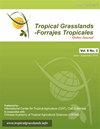尿赤藻的研究。日本冲绳的MG5 Vitória:植物繁殖和拖拉机轮胎应力测试
IF 0.7
4区 农林科学
Q3 AGRICULTURE, DAIRY & ANIMAL SCIENCE
引用次数: 0
摘要
饲喂优质牧草对于确保种牛保持健康和高繁殖率以及生长和育肥牛获得良好的生长速度至关重要。巴西草的栽培品种,乌氏草(Urochloa brizantha)。MG5 Vitória营养丰富,以耐旱著称。鉴于该品种在日本亚热带地区种子生产潜力较低,且进口种子存在植物检疫问题(土壤颗粒污染),在冲绳进行了2种无性繁殖方法的研究。在离地面约10厘米处剪下茎(秆),并将其插入50:50的堆肥中3厘米:土壤混合物,在温室中生根植株的成功率为77%,而从基部3个节点处剪下茎(秆)的成功率为67%,随后在最低节点上形成不定根2周,然后在根系出现的节点以下剪下,并将生根的繁殖体种植在相同的混合物中。从地面上砍下约10厘米的茎,并将其插入合适的土壤和堆肥混合物中,这一简单的过程似乎应该会产生可接受的产量,用于建立MG5饲料作物。然而,寻找一个没有植物检疫问题的高质量种子来源似乎是一个更好的解决方案,以增加冲绳种植面积到MG5。在为期2年的拖拉机轮胎压力试验中,一种MG5饲料作物的种子在拖拉机轮胎压力的作用下产量下降,但与冲绳常用的草料氯叶草(Chloris gayana)表现一样好。本文章由计算机程序翻译,如有差异,请以英文原文为准。
Studies with Urochloa brizantha cv. MG5 Vitória in Okinawa, Japan: Vegetative propagation and a tractor tyre stress test
Feeding of high quality grass is critical to ensure breeding cows remain healthy with high reproductive rates and growing and fattening cattle achieve good growth rates. The Brazilian grass cultivar, Urochloa brizantha cv. MG5 Vitória, is highly nutritious and is known for its drought tolerance. In view of its low seed production potential in subtropical Japan and of phytosanitary problems (contamination with soil particles) of imported seed, a study was conducted in Okinawa to assess 2 methods of propagating this cultivar vegetatively. Cutting stems (culms) at about 10 cm from ground level and inserting them 3 cm into a 50:50 compost:soil mixture produced a 77% success rate in terms of rooted plantlets in a glasshouse compared with 67% for cutting the culm at 3 nodes from the base, subsequently allowing 2 weeks for adventitious roots to form on the lowest node, then cutting below the node where roots emerged and planting the rooted propagule in the same mixture. It seems that the simple process of cutting stems at about 10 cm from ground level and inserting them into a suitable mixture of soil and compost should result in an acceptable yield of plantlets for establishment of an MG5 forage crop. However, locating a source of high-quality seed free of phytosanitary problems seed would seem to be a better solution to increase the areas in Okinawa planted to MG5. In the tractor tyre stress trial conducted over 2 years, an MG5 forage crop established from seed showed depressed yields on the treatment subjected to tractor tyre pressure but performed as well as Chloris gayana, a much-used forage grass in Okinawa.
求助全文
通过发布文献求助,成功后即可免费获取论文全文。
去求助
来源期刊

Tropical Grasslands-Forrajes Tropicales
Agricultural and Biological Sciences-Agronomy and Crop Science
CiteScore
1.60
自引率
0.00%
发文量
36
审稿时长
16 weeks
期刊介绍:
The Journal publishes, in English or Spanish, Research Papers and Short Communications on research and development, as well as contributions from practitioners (Farmer Contributions) and Review Articles, related to pastures and forages in the tropics and subtropics. There is no regional focus; the information published should be of interest to a wide readership, encomprising researchers, academics, students, technicians, development workers and farmers.
In general, the focus of the Journal is more on sown (''improved'') pastures and forages than on rangeland-specific aspects of natural grasslands, but exceptions are possible (e.g. when a submission is relevant for a particularly broad readership in the pasture and forage science community).
The Journal will also consider the occasional publication of associated, but closely related, research in the form of an additional scientific communication platform [e.g. a re-make of the former Genetic Resources Communication series of the former Division of Tropical Crops and Pastures of the Commonwealth Scientific and Industrial Research Organisation (CSIRO), Australia].
Areas of particular interest to the Journal are:
Forage Genetic Resources and Livestock Production[...]
Environmental Functions of Forages[...]
Socio-economic Aspects[...]
Topics within the aforementioned areas may include: Diversity evaluation; Agronomy; Establishment (including fertilization); Management and utilization; Animal production; Nutritive value; Biotic stresses (pests and diseases, weeds); Abiotic stresses (soil fertility, water, temperature); Genetics and breeding; Biogeography and germplasm collections; Seed production; Ecology; Physiology; Rhizobiology (including BNF, BNI, mycorrhizae); Forage conservation; Economics; Multilocational experimentation; Modelling.
 求助内容:
求助内容: 应助结果提醒方式:
应助结果提醒方式:


